cef64408e486da54b882bee63cf3dced.ppt
- Количество слайдов: 75

Black Holes in Universe From Stellar Masses to Supramassive Objects in Galaxies Max Camenzind Center for Astronomy Heidelberg (ZAH) @ Landessternwarte (2005)

Prologue: Chandrasekhar 1983 • „The black holes of nature are the most perfect macroscopic objects there are in the universe: the only elements in their construction are our concepts of space and time. And since the general theory of relativity provides only a single unique family of solutions for their descriptions, they are the simplest objects as well. “ • No matter is involved in their construction [i. e. no EOS], a Black Hole is a global vacuum solution with horizon, a kind of gravitational soliton. in Chandrasekhar (1983): „The Mathematical Theory of BHs“

Topics • The Long History of Black Hole Physics. • The Year 1963 and Kerr Black Hole Gravitational field is not Newtonian ! • Evidence for the Existence of Black Holes 4 Classes of Astrophysical Objects. „No Hair Plane (Glatzenebene)“ (M, a). • Accretion: New Paradigm of disk accretion onto Black Holes (Balbus & Hawley 1991). • Magnetic Fields - The Spin Paradigm: The Ergosphere as a Source of Energy Launch Jets (Blandford & Znajek 1977) still largely not understood. • Beyond Einstein ? Dreams and Future

The Long Way towards BHs • 1915: Einstein postulates the field equations (together with Hilbert). • 1916: Schwarzschild Solution Schwarzschild radius RS = 2 GM/c² = 3 km M / MS • Einstein denied the reality of Black Holes … He considered Black Holes as a mere mathematical curiosity. • This view changed after his death detection of Quasars (> 1963) observation of Cygnus X-1 (1971)

1963 – Foundation of Black Holes 1923 - Milestone 1: George Birkhoff: Schwarzschild spacetime geometry is the unique spherically symmetric solution of the Einstein vacuum field equations • 1939 - Robert Oppenheimer & Hartland Snyder show gravitational collapse of a pressureless homogeneous fluid sphere formation of a trapped region • 1963 – Milestone 2: Roy Kerr solves the Einstein vacuum field equations for uncharged symmetric rotating systems • 1963 – Milestone 3: Quasars are detected fuelled by accretion onto Black Holes • 1965 - Ezra Newman and collaborators solve the Einstein -Maxwell equations for charged rotating systems • 1967 - Werner Israel presents proof of a "no hair" theorem

1968 – 1977: Golden Age • 1968 – Brandon Carter uses Hamilton-Jacobi theory to derive 1 st-order equations of motion for particle moving in Kerr black holes Kerr Ray-Tracing • 1969 - Roger Penrose discusses the Penrose process for the extraction of the spin energy from a Kerr black hole Free energy of BHs • 1971 – Milestone 4: Identification of Cygnus X-1/HDE 226868 as a binary black hole candidate system. • 1973 - David Robinson completes the proof of the uniqueness theorem for Kerr black holes • 1977 – Milestone 5: Blandford-Znajek Process electromagnetic spin energy extraction from rotating black holes

4 Laws of Black Hole Mechanics • 1972 - Stephen Hawking proves that the area of a classical black hole's event horizon cannot decrease. • 1972 - Jacob Bekenstein suggests that black holes have an entropy proportional to their surface area due to information loss effects • 1973 - James Bardeen, Brandon Carter, and Stephen Hawking propose 4 laws of black hole mechanics in analogy with laws of thermodynamics Free energy • 1973 - Stephen Hawking applies quantum field theory to black hole spacetimes and shows that black holes will radiate particles with a black-body spectrum which can cause black hole evaporation concept is important, but astrophysically not relevant, and still debated.

1978 – 2005: Observations • 1978 – Sargent et al. show evidence for a supermassive BH in the center of Messier 87 (“serious possibility”). This has been very much debated but confirmed ! • 1992 – Microquasar GRS 1915+105 found. • 1997 – Fe line redshifts of the innermost portions of accretion disks around rotating supermassive black holes • 2000 - Evidence for the hypothesis that Sagittarius A* is a supermassive black hole at the centre of the Milky Way galaxy • 2002 – The most distant Black Hole found: Cosmological Redshift z = 6. 43 ! (< 1 Gyear old) • 2005 – BHs confirmed in ~ 20 X-Ray Binary Systems ! • 2005 – BHs confirmed in ~ 30 nearby galactic centers ! • 2005 – BHs found in ~ 100, 000 Quasars !

The Year 1963 and the Physics of Kerr Black Hole

How to Treat Gravity of BHs ? In GR the spacetime is a differentiable manifold. The most natural thing is to to foliate it in t=const spatial hypersurfaces St. 1 Measures the “clocks ticking rates” on two St Measures the “stretching” of coordinates St 4 6 Measures distances among points on a St unit timelike 4 -vector normal to St

Spacetime is stationary and axisymmetric 2 Parameters: (i) Mass M (ii) Ang. Mom. a „Charge not relevant in Astrophysics“ Event Horizon r. H = M + (M² - a²)1/2

Source: Mass Source: Ang. Mom. Also for NSs !

Gravity Probe-B will confirm the Existence of Gravitomagnetism



4 Laws of BH Mechanics Bekenstein 1973, Bardeen et al. 1973, Hawking 1974, 1975



Extracted by magnetic effects

Blandford-Znajek Process Load at infinity J Blandford & Znajek (1977) „Split-Monopole“ magnetosphere coupled to rotating Horizon with Znajek Horizon bc drives closed current system Subject of strong criticism (Punsley)

A Modern Version of BZ Mechanism OLC: Outer Light Surface, compact for Black Holes A: Alfven Surface Plasma injection from near ms orbit; Plasma accretion causal: slow ms, Alfven and fast ms points Proto-Jet wwwww Current Sheet Magnetic fields advected from „Infinity“

Twisting of Magnetic Fields • Except for induction terms, evolution of toroidal magnetic field ~ Newtonian MHD • Source: Differential plasma rotation • Schwarzschild: no shear ! • Extreme Kerr: biggest effect ! T ~ RBf Operates outside horizon

Black Holes 2 Energy Reservoirs • Potential energy tapped by accretion X-rays • Rotational energy tapped by magnetic fields, similar to rotating neutron stars (Blandford & Znajek 1977) will feed energy of JETS ! LRot = ERot/tbrake ~ 1046 erg/s (MH/109 MS) (t. H/tbrake) LRot = ERot/tbrake ~ 1038 erg/s (MH/10 MS) (t. H/tbrake) tbrake = f (a, B, …) [BZ 1977] LBZ = k BH² r. H²c (a/M)² (WF[WH-WF]/WH²) ~ MH

Anatomy of Black Holes

Black Hole Ergosphere Extended Boundary Layer For a > 0. 7, radii move inside ergosphere

Each form of matter will be driven to corotation within the ergosphere ! Boundary Layer near Horizon ~ r. H WH = w(r. H) In Schwarzschild: No rotation near Horizon !

a = 0. 5 a = 1. 0

Outflows in Quasars & Micro. Quasars ? „Stochastic Funnel. Flow“ Krolik 2005 Conical Outflow Disk Inflow

Field Line Twisting by Rotating Black Holes a=0 a = 0. 5 a = 0. 9 a =. 998 GRMHD Simulations (Hawley et al. 2005)

Astrophysical Black Holes in the Universe
![Black Holes as Astrophysical Objects • [ Primordial Black Holes: M < 2 MS] Black Holes as Astrophysical Objects • [ Primordial Black Holes: M < 2 MS]](https://present5.com/presentation/cef64408e486da54b882bee63cf3dced/image-31.jpg)
Black Holes as Astrophysical Objects • [ Primordial Black Holes: M < 2 MS] • Stellar Black Holes: 2. 2 MS < M < 100 MS • Intermediate Mass Black Holes 100 MS < M < 105 MS (? ) • Supermassive Black Holes: 105 MS < M < 1010 MS reside in center of galaxies at all redshifts, 0 < z < 10 (? ).

1971 monitored by UHURU High-Mass XB Cygnus X-1 Black Holes are formed in stellar Collapse >100. 000 BHs in the Galaxy

Cyg X-1 – Activity Cycles (VLA / RXTE) Radio X-Rays HX When high in X-rays minimum in radio and vice versa Jet launch

Low-Mass X-Ray Binaries

DIFFERENT BINARY SYSTEMS • type of the donor star type of accretion (wind or Roche lobe overflow) • very different scales: Every X-ray binary is a possible microquasar! J. A. Orosz

Stellar Mass Spectrum Clear Separation NSs vs BHs NS

X-Ray Emission: VARIABILITY on all Time Scales GX 339 -4 lightcurve • Variations = changes in the state of the source • lightcurves: GX 339 -4 / GRS 1915+105 Variations on very different time scales ! “easy” observations for human time scale 1996 2003 GRS 1915+105 X (2 -10 ke. V) Radio (2, 25 GHz) Rau et al (2003)

accretion / ejection coupling Mirabel et al (1998) Marscher et al (2002) • cycles of 30 minutes in GRS 1915+105 : ejections after an X-ray dip refilling of the internal part of the disc ? transient ejections during changes of states same phenomenum in the quasar 3 C 120 ? far slower !

GRS 1915+105 Microquasar

SUPERLUMINAL EJECTIONS same Lorentz factor as in Quasars : ~ 5 -10 VLBI at 22 GHz ~ 1. 3 cm VLA at 3. 5 cm ~ arcsec. scale ~ milliarcsec. scale • • ~103 Mirabel & Rodriguez (1994) Move on the sky plane times faster Jets are two-sided (allow to solve equations max. distance)

QUASARS MICROQUASARS Quasar 3 C 223 VLA at 1477 MHz ~ 20 cm Microquasar 1 E 1740. 7 -2942 radio (VLA) observations at 6 cm Mirabel et al. 1992

Non-thermal Radio Plasma ----- 100 kpc ------ Black Holes in E-Galaxies Drive Jets Cygnus A (VLA) 3 C 219 (VLA)

A. Müller (LSW) 2004

Black Hole Mass ~ Bulge Mass for Inactive Galaxies 30 Nearby Galaxies: MH ~ 0. 14% MB Magorrian Relation (N. Häring & H. -W. Rix: Ap. JL 2004)

Mass vs Luminosity of Quasars LE = 2 x 1031 Watt x (M/MS) ~ 5 x 104 LS maximum luminosity minimum mass for BHs

Black Hole „Two-Hair Plane“ BH s in Galactic Centers and QSOs Neutron Stars Microquasars, Stellar BHs, M* > 30 Intermediate Mass BHs ? ? ? Population III BHs at High Redshifts RL Quasars, Radio Galaxies

Spin a of a Black Hole can be determined from Photon Propagation Equations of geodesics integrable Carter Integrals

Image of a Ring

Line Emission from BH Accretion

Schwarzschild Extreme Kerr Extreme Redshift

High. Redshift Quasars (SDSS) Form in Primordial Clusters Very massive BHs form very early !

Cosmic Quasar Population H 0 = 70 km/s/Mpc Wk = 0. 0 Wm = 0. 3 WL = 0. 7 QSO densities augmented by factor 3 due to obscuration M. Camenzind 2005

Cosmic History & Black Holes recombination Cosmic Dark Age: no light no star, no quasar; IGM: HI First light: the first galaxies and quasars in the universe Epoch of reionization: radiation from the first object lit up and ionize IGM : HI HII reionization completed, the universe is transpartent and the dark ages ended today

Credit: G. Fishman et al. , BATSE, CGRO, NASA BATSE GRB Final Sky Map: Astronomy Picture of the Day 2000 June 28

Gamma-Ray Burst Durations Two Populations: Short – 0. 03 -3 s Long – 3 -1000 s Possible third Population 1 -10 s

A Slow Explosion of massive star Formation of rotating BH with JETS long duration burst Credit: Y. Grosdidier (U. Montreal) et al. , WFPC 2, HST, NASA “Astronomy Picture of the Day: 2003 March 25”

Merging of 2 neutron stars short bursts formation of a BH On the Origin of Gold: Astronomy Picture of the Day: 2005 May 15

New Insight: Accretion is Turbulent - not Viscous New Paradigm for ADs: Disks are not viscous – Disks are turbulent Turbulence driven by weak magnetic fields Radiative MHD key vehicle [Balbus & Hawley 1991, 98]

New Paradigm: BHs in Different Accretion States • BHs grow by accretion processes. • MHD turbulence drives angular momentum transport in acretion disks (Balbus & Hawley magnetorotational instability, MRI). Disks are turbulent, not viscous ! • The well-known thin disk accretion model (Shakura & Sunyaev) only applies for high accretion rates, typically more than a few percent Eddington. • Truncated accretion at lower rates.

Two different accretion states depending on the accretion rate for given mass

Brinkmann & Camenzind LSW 2004

Esin et al. 1995 A. Müller (LSW 2004)
![Accretion States of Cyg X-1 High State (HS) [truncation radius near rms] Low State Accretion States of Cyg X-1 High State (HS) [truncation radius near rms] Low State](https://present5.com/presentation/cef64408e486da54b882bee63cf3dced/image-63.jpg)
Accretion States of Cyg X-1 High State (HS) [truncation radius near rms] Low State (LS) [truncation radius moves away] Transitions Energy emitted in Comptonized photons

What tell us X-rays? MCG-6 -30 -15 HST/WFPC-2 XMM-Newton 0. 5 -10 ke. V light curve (Fabian et al. 2002) Rapid X-ray variability of AGN strongly suggests X-rays come from innermost regions of accretion disk
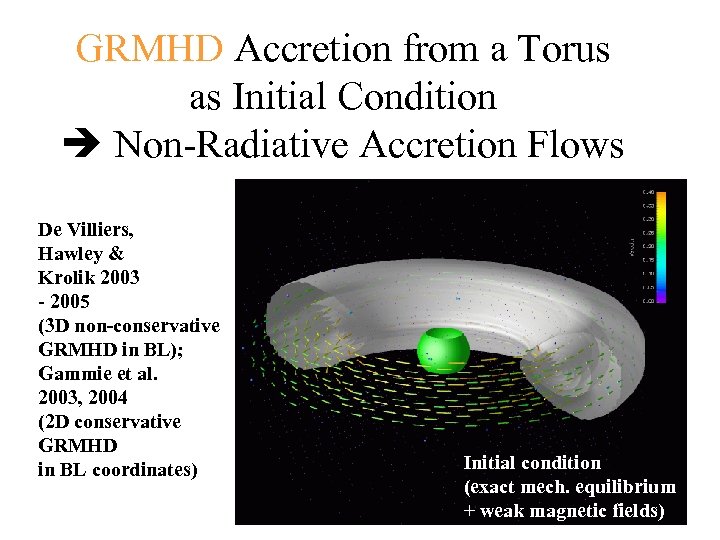
GRMHD Accretion from a Torus as Initial Condition Non-Radiative Accretion Flows De Villiers, Hawley & Krolik 2003 - 2005 (3 D non-conservative GRMHD in BL); Gammie et al. 2003, 2004 (2 D conservative GRMHD in BL coordinates) Initial condition (exact mech. equilibrium + weak magnetic fields)

Meridional Plane through a BH Funnel Outflows Colour: Density Torus + weak magnetic fields Initial State Turbulent Thick Disk Keplerian „Final State“ Gammie et al. 2004

Magnetic Fields (originally confined to torus) evolve towards a completely turbulent state. Angular momentum is transported outwards, some accreted to spin up BH.

Fender 2004; Belloni 2005
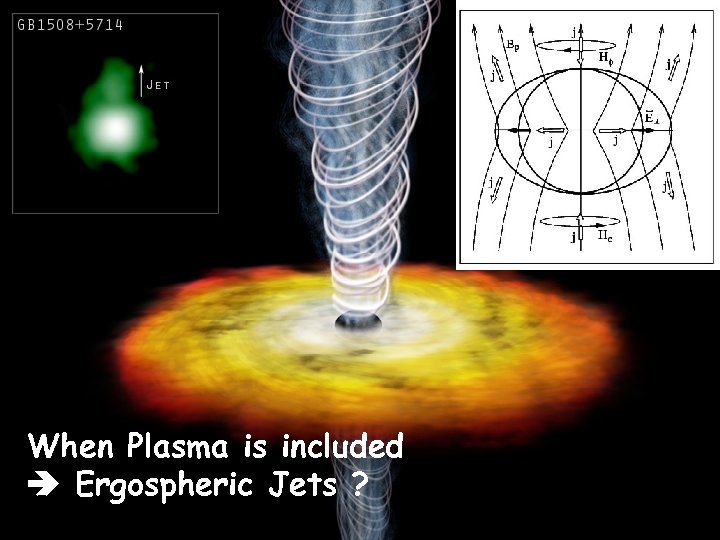
When Plasma is included Ergospheric Jets ?

Beyond Einstein – The Observer‘s Dreams Planck XEUS XMM Today 2012 2020 2030 NASA Homepage
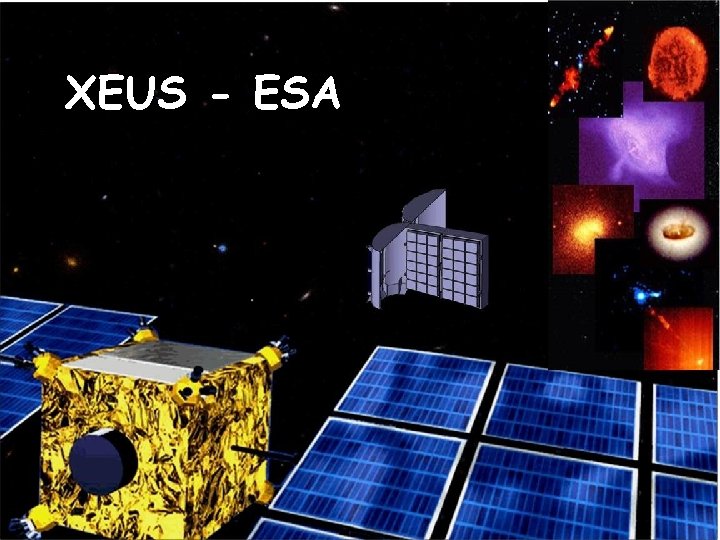
XEUS - ESA
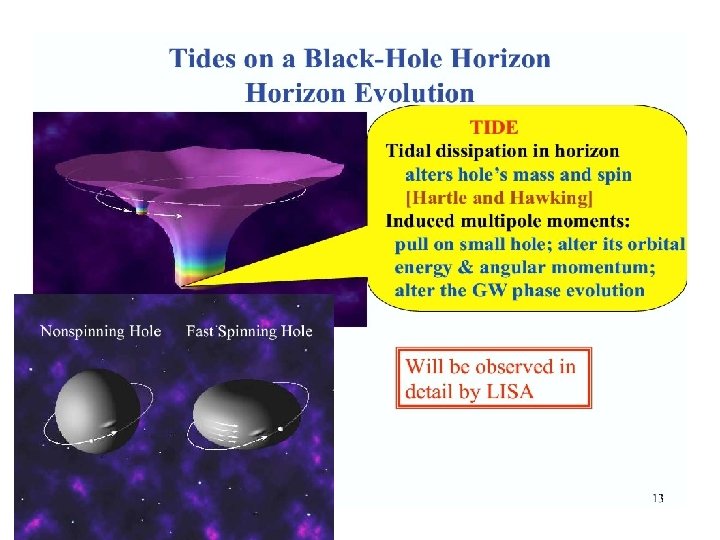

Beyond Einstein – Heavy Numerical Computations Robust parallel GRMHD Codes
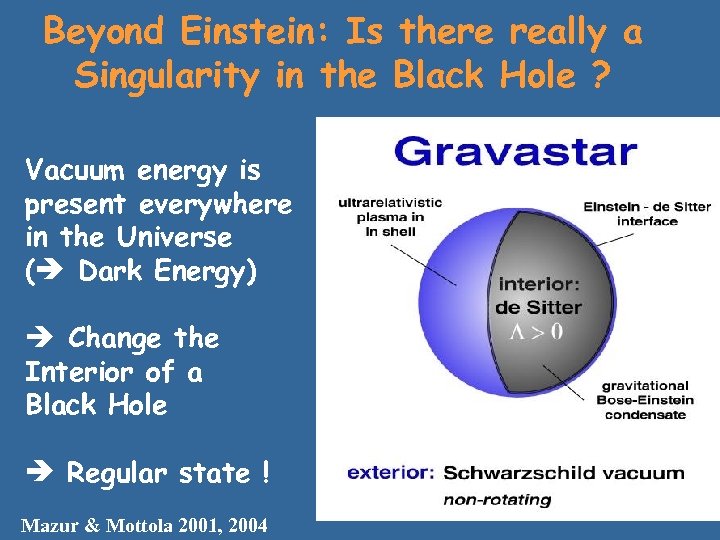
Beyond Einstein: Is there really a Singularity in the Black Hole ? Vacuum energy is present everywhere in the Universe ( Dark Energy) Change the Interior of a Black Hole Regular state ! Mazur & Mottola 2001, 2004
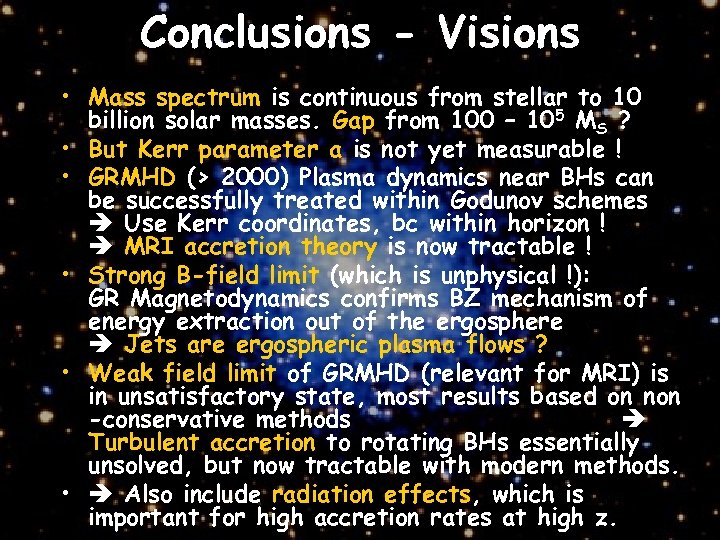
Conclusions - Visions • Mass spectrum is continuous from stellar to 10 billion solar masses. Gap from 100 – 105 MS ? • But Kerr parameter a is not yet measurable ! • GRMHD (> 2000) Plasma dynamics near BHs can be successfully treated within Godunov schemes Use Kerr coordinates, bc within horizon ! MRI accretion theory is now tractable ! • Strong B-field limit (which is unphysical !): GR Magnetodynamics confirms BZ mechanism of energy extraction out of the ergosphere Jets are ergospheric plasma flows ? • Weak field limit of GRMHD (relevant for MRI) is in unsatisfactory state, most results based on non -conservative methods Turbulent accretion to rotating BHs essentially unsolved, but now tractable with modern methods. • Also include radiation effects, which is important for high accretion rates at high z.
cef64408e486da54b882bee63cf3dced.ppt